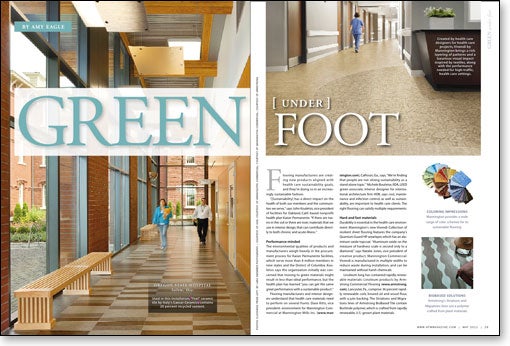Green under foot

Click the above image for a PDF download
Flooring manufacturers are creating new products aligned with health care sustainability goals, and they're doing so in an increasingly sustainable fashion.
"[Sustainability] has a direct impact on the health of both our members and the communities we serve," says John Kouletsis, vice president of facilities for Oakland, Calif.-based nonprofit health plan Kaiser Permanente. "If there are toxins in the soil or there are toxic materials that we use in interior design, that can contribute directly to both chronic and acute illness."
Performance-minded
The environmental qualities of products and manufacturers weigh heavily in the procurement process for Kaiser Permanente facilities, which serve more than 8 million members in nine states and the District of Columbia. Kouletsis says the organization initially was concerned that moving to green materials might result in less-than-ideal performance, but the health plan has learned "you can get the same great performance with a sustainable product."
Flooring manufacturers and interior designers understand that health care materials need to perform on several fronts. Dave Kitts, vice president-environment for Mannington Commercial at Mannington Mills Inc. (www.mannington.com), Calhoun, Ga., says, "We're finding that people are not siloing sustainability as a stand-alone topic." Michele Bouterse, IIDA, LEED green associate, interior designer for international architecture firm HOK, says cost, maintenance and infection control, as well as sustainability, are important to health care clients. The right flooring can satisfy multiple requirements.
Hard and fast materials
Durability is essential in the health care environment. Mannington's new Vivendi Collection of resilient sheet flooring features the company's Quantum Guard HP wearlayer, which has an aluminum oxide topcoat. "Aluminum oxide on the measure of hardness scale is second only to a diamond," says Natalie Jones, vice president of creative product, Mannington Commercial. Vivendi is manufactured in multiple widths to reduce waste during installation, and can be maintained without harsh chemicals.
Linoleum long has contained rapidly renewable materials. Linoleum products by Armstrong Commercial Flooring (www.armstrong.com), Lancaster, Pa., comprise 36 percent rapidly renewable cork, linseed oil and wood flour, with a jute backing. The Striations and Migrations lines of Armstrong BioBased Tile contain BioStride polymer, which is crafted from rapidly renewable, U.S.-grown plant materials.
Rubber flooring, like that by Nora Systems Inc. (www.nora.com/us), whose U.S. headquarters is in Salem, N.H., also includes rapidly renewable material.
Recycled content
Many flooring products include recycled content. Melissa Vernon, director of sustainable strategy, InterfaceFLOR (http://interfaceflor.com), LaGrange, Ga., says her company is switching from virgin raw materials to recycled content where possible because the extraction and processing of raw materials account for most of carpet's environmental footprint. InterfaceFLOR carpet tiles use 100 percent recycled Nylon 6, and backing with up to 79 percent recycled content. The company's Convert design platform includes products containing up to 75 percent total recycled content, including up to 35 percent postconsumer content, depending on style and color.
Shaw Contract Group is a commercial carpeting division of Shaw Industries Group Inc. (www.shawcontractgroup.com), Dalton, Ga. When products using Shaw's EcoWorx backing reach the end of their useful lives, the company collects them for recycling at no charge to the customer. EcoWorx backing is recycled directly into new EcoWorx backing, and carpet fibers are recycled into Eco Solution Q nylon, which is used in nearly all the company's products, says Paul Young, director of health care markets, Shaw Contract Group.
Indoor air quality
To protect indoor air quality, the Resilient Floor Covering Institute (RFCI) and the Carpet and Rug Institute (CRI) certify resilient flooring and carpet products that comply with established emissions criteria for volatile organic compounds (VOCs). Certified products receive the RFCI FloorScore seal or CRI Green Label or Green Label Plus.
Glue-free adhesives, like InterfaceFLOR's TacTiles and Shaw Contract Group's LokDots, have no odor and virtually no VOCs. These products weigh significantly less than traditional adhesives; 1.1 pounds of LokDots pressure-sensitive adhesive installs the same amount of carpet tile as a 35-pound bucket of adhesive, according to the company. This makes these adhesives more efficient and less costly to ship.
Natural look
Sustainability even plays a role in flooring aesthetics. InterfaceFLOR's i2 design platform uses the principle of biomimicry, or imitating the designs of nature, to vary pattern and color within a single style. There is no need to match dye lots when replacing tiles, so facilities can keep less stock on hand. Vernon says using natural patterns also can create a calmer, more relaxing environment. "You have to think about sustaining people, too," says Gail Nash, vice president of health care strategy, InterfaceFLOR.
Dominic Rice, vice president, Armstrong Commercial, notes that a floor's life span can be extended by appropriate designs that remain relevant for a long period. "A long service life is a key driver to sustainability," he says.
Manufacturer commitment
Flooring manufacturers are making a commitment to environmental responsibility that goes beyond their product lines. Mannington Mills Inc. has defined eight specific corporate values to guide its environmental policy, such as: "We invest in technology and resources to assure environmental improvements." The company says it is committed to ensuring that its business has no adverse effects on the health and safety of its associates, customers, local residents or the environment.
Shaw Industries' most recent sustainability report outlines a multitude of company programs covering energy and water conservation, indoor air quality, recycling and reclamation, and social and community responsibility.
Armstrong has separate initiatives for greenhouse gases, energy, water and forest management; the company also is working to increase sustainability in the supply chain, says Jennifer Gaalswyk, corporate manager, product stewardship, Armstrong Commercial.
InterfaceFLOR's Mission Zero project has the goal of eliminating any negative environmental impact from the company by 2020. As part of this mission, InterfaceFLOR generates its own carbon offsets to balance every pound of greenhouse gas emissions created in the fulfillment of each customer order with investments in projects like renewable energy.
Details about each company's environmental efforts are available on its website.
'Total health environment'
Hospitals, too, are finding sustainability to be an important part of their public identity. "Our clients are using it as part of their marketing materials," says Diana Kissil, AIA, principal at the San Francisco office of architecture, engineering and planning firm SmithGroupJJR. "If you're going to do a state-of-the art health care facility, it has to be environmentally friendly. A total health environment includes all the materials that you're putting into the interior."




